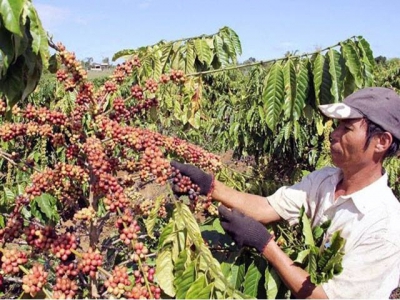Removing difficulties for coffee industry

Currently, the export price of Robusta coffee grad 2, with 5% black and broken, reached only US$1,401 per tonne at Ho Chi Minh City’s ports.
According to the Vietnam Coffee Association, the world market outlook for robusta coffee was quite gloomy in September. Currently, the export price of Robusta coffee grad 2, with 5% black and broken, reached only US$1,401 per tonne at Ho Chi Minh City’s ports, down 0.8% over the end of August.
The above price is a big loss for both coffee growers and traders in Vietnam, where Robusta accounts for over 90% of the export volume of the coffee industry. Economic experts said that, in addition to objective reasons due to production, the record increase in the output from the world's biggest coffee producer, Brazil, was one of main causes putting pressure on the price of Vietnamese coffee.
Currently, the Robusta coffee growing area accounts for nearly 94% of coffee areas in the country and many areas are old and stunted and have poor quality and yield. The Arabica coffee area is around 40,000 hectares, mainly old varieties with low productivity and quality.
The re-cultivation of coffee trees has not been developed in these localities and the processing technology is backward, affecting the products’ quality. As a consequence, Vietnam’s export coffee price was much lower than other countries. For example, in the US market, the average coffee price from Vietnam was only US$1.9 per kilogramme, meanwhile the coffee from Brazil, Columbia and Guatemala were priced at US$2.8 per kilogramme, US$3.5 per kilogramme and US$4 per kilogramme, respectively.
It is forecast that the global coffee output in the 2018-209 crop will increase by 7.1% compared to the 2017-2018 crop and domestic coffee production is expected to rise around 4%. Currently, the price of coffee production in the Central Highland provinces is only VND32,000 per kilogramme – the lowest in recent years.
Facing difficulties in price, in the immediate future, coffee growers should save input costs to reduce production costs and maintain orchards. Most coffee growers borrowed capital from credit institutions for their production and business. Therefore, the relevant agencies need to enhance the implementation of debt freezing and rescheduling policies, as well as reduce interest rates for farmers receiving loans.
In the long run, in order to boost the export value of coffee, farmers should strictly implement intensive farming and care methods, creating coffee products with good quality. In addition, management agencies need to focus on re-planning plantation areas, expeditiously completing the re-cultivation and building brands for the coffee industry, as well as moving from the export of raw coffee beans to deep processing and joining the global value chain.
Có thể bạn quan tâm
 Efficiency from solutions in hi-tech agricultural development
Efficiency from solutions in hi-tech agricultural development The province is now home to around 2,754 hectares of farming land with hi-tech application, up 78.5% compared to 2015
 Ninh Thuận farmers strike it rich with aloe vera
Ninh Thuận farmers strike it rich with aloe vera Aloe vera farming has helped farmers in the south-central province of Ninh Thuận adapt to climate change and earn steady incomes since thanks to high demand
 The Head of the hamlet persists in bringing Sachi plants to the poor homeland
The Head of the hamlet persists in bringing Sachi plants to the poor homeland Ms. Ha Thi Hanh, the Head of Khang Hamlet, Dich Giao commune (Tan Lac) already met directly the Deputy Director of the company to discuss about the model.